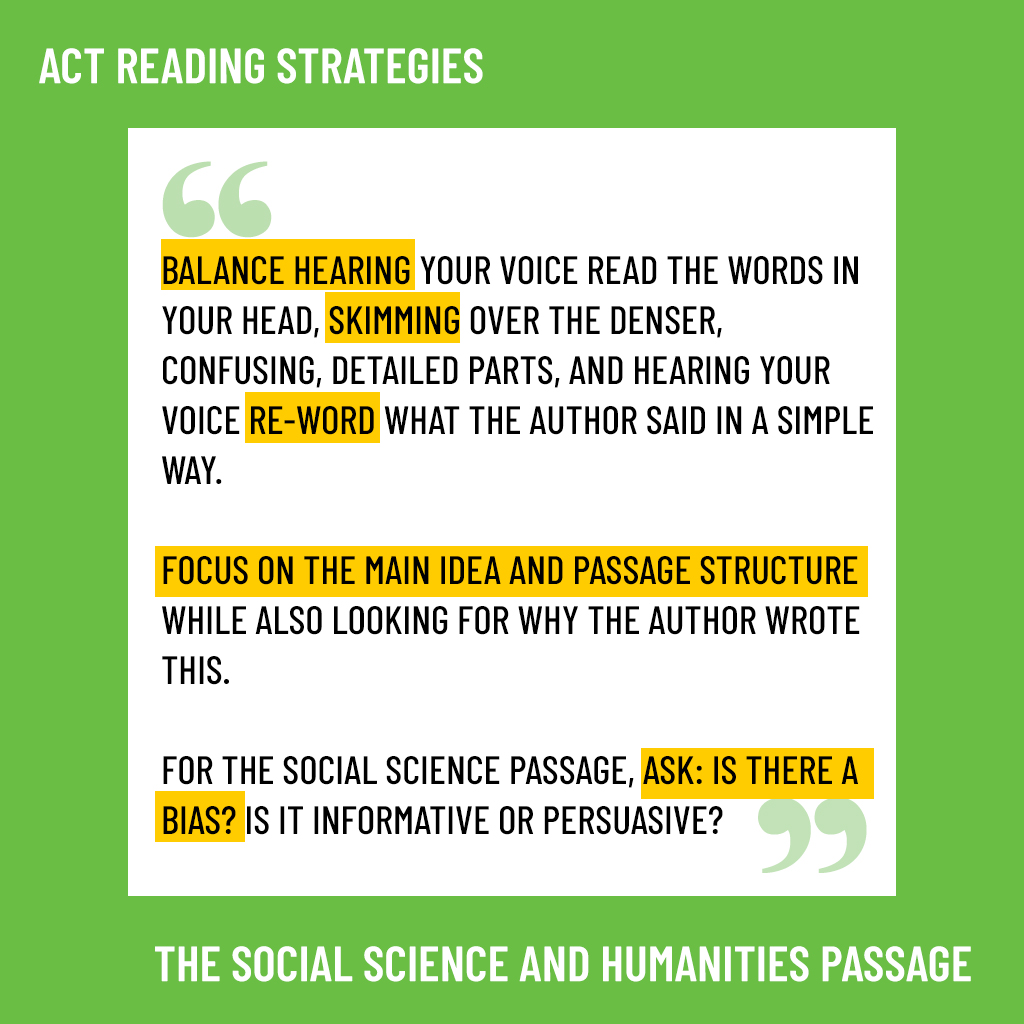The ACT Reading section is made up of four passages with about 10 questions each (40 total). There are four main types of passages that you will encounter on the ACT Reading section: literary narrative/prose fiction passages, natural science, social science, and humanities.
One difference between the ACT and the SAT you can use to your advantage is that the ACT Reading passages are always in the same order: prose, social science, humanities, and natural science. That makes it easier to change the order of how you might do these passages, especially if there is a passage that you struggle with or one that takes more time to do.
How to Ace the ACT Reading Section
In this post, we’ll cover strategies for the social science and humanities passages you’ll see on the ACT. These passage types are pretty similar so we’ve combined them into one post.
What is the Social Science Passage? What is the Humanities Passage?
The social science passage is about the economy, psychology (the study of the human mind and human behavior), sociology (the study of human society), or even a historic document, like something written by the founding fathers.
Partly because of the wide variety of content possible, the social science passage can be one of the trickiest passages to read. Often the passage is dense with lots of vocabulary words that you may or may not be familiar with, along with long, rambling sentences. These passages are informative but have a bias. Bias means that the author is trying to convince you of a perspective, point of view, and/or argument. You need to treat the social science passage like a combination of narrative and informative (a cross between how you read the prose and natural science passages).
Social science passages are informative but have a bias. Bias means that the author is trying to convince you of a perspective, point of view, and/or argument.
Like the social science passages, the humanities passage covers a wide variety of content. A humanities passage could be about art or ethics. It could be an essay or speech by a famous historian or about a well-known historical moment. Sometimes the author of the essay is unknown but the theme is relatable – coping with family dynamics, balancing cultural traditions and current ones, facing conflict, or working through emotions.
The humanities passage can best be described as informative with a purpose. Having a purpose does not necessarily mean that there is a bias. Though a bias is possible, the purpose of the passage could be to describe a concept in order to build up to a conclusion. No matter what, your job is to determine the purpose of the passage.
The humanities passage can best be described as informative with a purpose. No matter what, your job is to determine the purpose of the passage.
Pacing Your Reading
Since the social science passage is like a combination of the prose and natural science passage, your pacing strategy is a combination of how you read those two passages as well. Your job is to read, skim, and re-word ideas. The idea is that you are “hearing” your voice as you read until you hit a dense sentence, then you skim through it. (Read more about skimming here.) Once you have reached the end of the difficult part or sentence, you take a second (literally about one second) and “say” in your head as simply as possible what exactly that part/sentence meant.
Your job is to read, skim, and re-word ideas. The idea is that you are “hearing” your voice as you read until you hit a dense sentence, then you skim through it. Once you have reached the end of the difficult part or sentence, you take a second (literally about one second) and “say” in your head as simply as possible what exactly that part/sentence meant.
Like the social science passage, the language of the humanities passage can be dense and/or contain unfamiliar vocabulary. So what you “hear” in your head is going to vary. Depending on your interests and what you read on your own time, you may luck out with a passage that keeps you interested. When your interest is peaked, you will be able to read a bit faster and retain the content, like you would on a prose passage. So this means that the more interested you are, the more clearly you will hear your voice reading in your head and the faster you will read.
If you find the passage boring, then you don’t want to get bogged down. Instead, you’ll need to increase your reading speed because you are more likely to have to return to the passage for more questions, so you’ll need to save time during the passage reading in order to have more time when answering questions.
How to Stay Focused on the ACT Reading Section
So if you are less interested, then skim and focus on the structure of the passage and determining both the main idea of the passage and the author’s purpose in writing it, like you would on a natural science passage. Remember, when you skim you will still hear your voice when you read certain parts. The rest of the time is more of a mumble with quick re-word phrasing of what you have read, especially if the text is dense.
What to Look for on the Social Science and Humanities Passages
As you are reading, two important things to look out for are the tone of the passage and the author’s purpose.
For both passages, understanding the tone is key to answering the questions correctly. These passages will ask more inference questions than detail questions. While you can and will return to the passage for details, it is hard to return to a particular place in the passage to understand tone. Tone builds throughout the passage, and thus would require you to read the entire thing again if you missed it the first time! You must keep a watchful eye on the subtext of the passage – read not just the words at face value, but think about what the author really means.
For both passages, understanding the tone is key to answering the questions correctly. These passages will ask more inference questions than detail questions.
If the passage is dense, you will need to stop along the way to re-word what you have read. Otherwise, you could reach the end of the passage and have no idea what the passage is about! You must balance hearing your voice read the words, skimming over the denser, confusing, detailed parts, and hearing your voice re-word what the author said in a simple way.
For the social science passage in particular, you want to pay attention to the structure of the passage, the main idea of the paragraphs, and elements that support the argument, as well as any counterexamples. Furthermore, since this passage is not just informative, you must determine if there is an argument or bias. Noting transition words is key here – they help you identify what the author thinks, as well as what the author disagrees with.
The social science passage is not just informative; you must determine if there is an argument or bias. You want to pay attention to the elements that support the argument, as well as any counterexamples. Transition words will help you identify what the author thinks and what the author disagrees with.
The Key Strategies for the Social Science and Humanities Passages
Your strategy for the social science passage is a combination of strategies for the first two passage types. As you read, “hear” the words in your head, and use your intonation to help understand the subtext of each sentence. When you hit a dense, rambling sentence, then skim (mumble) through it. Once you have reached the end of the sentence, take a second (literally about one second) and “say” in your head as simply as possible what exactly that sentence meant.
You must balance hearing your voice read the words, skimming over the denser, confusing, detailed parts, and hearing your voice re-word what the author said in a simple way. Focus on the main idea and passage structure while also looking for why the author wrote this.
You must balance hearing your voice read the words, skimming over the denser, confusing, detailed parts, and hearing your voice re-word what the author said in a simple way. Focus on the main idea and passage structure while also looking for why the author wrote this. For the social science passage, ask: Is there a bias? Is it informative or persuasive?
About the Paired Passages
The paired passages are usually two natural science or social science passages. Your goal when reading these passages is to figure out how they relate. When considering how the passages relate to one another, think about these options:
- Do the passages express different opinions or perspectives on the same issue?
- Does one passage present a problem while the other passage offers a solution?
- Does one passage present a theory while the other passage offers evidence to support the theory?
- Or maybe each passage presents the same evidence but comes to differing conclusions?
Basically, the passages will agree on some points and disagree on others. To help you clarify what you’ve read, after you read the first passage write or think of one sentence to summarize the passage. Then after you read the second passage try to come up with one sentence that doesn’t just summarize the passage but relates it back to the first. The simpler the sentence the better!
Ready to start practice for the ACT Reading section? Our ACT course contains practice passages and questions for every kind of passage you’ll find on the ACT Reading section. Head on over to www.olive-book.com to enroll!
Further Reading:
How to Stay Focused on the ACT Reading Section
How to Ace the ACT Reading Section
The Importance of Making Time to Read for Fun
Pin, print, or save the image below to remember the key strategies for the social science and humanities passages:

